Genomic and Phylogenetic Analysis of Bacillus cereus Biovar anthracis Isolated from Archival Bone Samples Reveals Earlier Natural History of the Pathogen
Abstract
:1. Introduction
2. Results
2.1. Isolation and Identification of Bcbva from Archival Bone Samples
2.2. In Silico Multilocus Sequence Typing, MLVA, and Genomic Analysis of Bcbva
2.3. Earliest Isolate Shows Similarity to Ancestral B. cereus
2.4. Whole Genome SNP Trees Reveal Spatial and Temporal Patterns of Infection
2.5. Whole-Genome SNP Trees Allow for Accurate Case Clustering
2.6. Spatial Analysis of Genetic Similarity
3. Discussion and Conclusions
4. Materials and Methods
4.1. Isolation and Verification of Bcbva from Bones and Teeth
4.2. Genome Sequencing of Bcbva Performed Using the Illumina MiSeq
4.3. Sequence Processing and Bioinformatics Analysis
4.4. Exploratory Spatial Data Analysis of Bcbva Isolates from Taï National Park
4.5. Principal Component Analysis of Sample Metadata and Genetic Similarity
Supplementary Materials
Author Contributions
Funding
Institutional Review Board Statement
Informed Consent Statement
Data Availability Statement
Conflicts of Interest
References
- Bottone, E.J. Bacillus cereus, a Volatile Human Pathogen. Clin. Microbiol. Rev. 2010, 23, 382–398. [Google Scholar] [CrossRef] [PubMed]
- Stenfors Arnesen, L.P.; Fagerlund, A.; Granum, P.E. From Soil to Gut: Bacillus cereus and Its Food Poisoning Toxins. FEMS Microbiol. Rev. 2008, 32, 579–606. [Google Scholar] [CrossRef] [PubMed]
- Mikesell, P.; Ivins, B.E.; Ristroph, J.D.; Dreier, T.M. Evidence for Plasmid-Mediated Toxin Production in Bacillus anthracis. Infect. Immun. 1983, 39, 371–376. [Google Scholar] [CrossRef]
- Pasteur, L. De l’atenuation Des Virus et de Leur Retour a La Virulence. Compt. Rend. Acad. Sci. Parris 1981, 92, 429–435. [Google Scholar]
- Sterne, M. Variation in Bacillus anthracis. Onderstepoort J. Vet. Sci. Anim. Ind. 1937, 8, 271–349. [Google Scholar]
- Sterne, M. The Use of Anthrax Vaccines Prepared from Avirulent (Uncapsulated) Variants of Bacillus anthracis. Onderstepoort J. Vet. Sci. Anim. Ind. 1939, 13, 307–312. [Google Scholar]
- Hoffmaster, A.; Ravel, J.; Rasko, D.; Chapman, G.; Chute, M.; Marston, C.; De, B.; Sacchi, C.; Fitzgerald, C.; Mayer, L. Identification of Anthrax Toxin Genes in a Bacillus cereus Associated with an Illness Resembling Inhalation Anthrax. Proc. Natl. Acad. Sci. USA 2004, 101, 8449. [Google Scholar] [CrossRef] [PubMed]
- Hoffmaster, A.R.; Hill, K.K.; Gee, J.E.; Marston, C.K.; De, B.K.; Popovic, T.; Sue, D.; Wilkins, P.P.; Avashia, S.B.; Drumgoole, R.; et al. Characterization of Bacillus cereus Isolates Associated with Fatal Pneumonias: Strains Are Closely Related to Bacillus anthracis and Harbor B. anthracis Virulence Genes. J. Clin. Microbiol. 2006, 44, 3352–3360. [Google Scholar] [CrossRef]
- Leendertz, F.H.; Ellerbrok, H.; Boesch, C.; Couacy-Hymann, E.; Mätz-Rensing, K.; Hakenbeck, R.; Bergmann, C.; Abaza, P.; Junglen, S.; Moebius, Y.; et al. Anthrax Kills Wild Chimpanzees in a Tropical Rainforest. Nature 2004, 430, 451–452. [Google Scholar] [CrossRef]
- Leendertz, F.H.; Lankester, F.; Guislain, P.; Néel, C.; Drori, O.; Dupain, J.; Speede, S.; Reed, P.; Wolfe, N.; Loul, S.; et al. Anthrax in Western and Central African Great Apes. Am. J. Primatol. 2006, 68, 928–933. [Google Scholar] [CrossRef]
- Klee, S.R.; Ozel, M.; Appel, B.; Boesch, C.; Ellerbrok, H.; Jacob, D.; Holland, G.; Leendertz, F.H.; Pauli, G.; Grunow, R.; et al. Characterization of Bacillus anthracis-like Bacteria Isolated from Wild Great Apes from Cote d’Ivoire and Cameroon. J. Bacteriol. 2006, 188, 5333–5344. [Google Scholar] [CrossRef] [PubMed]
- Hoffmann, C.; Zimmermann, F.; Biek, R.; Kuehl, H.; Nowak, K.; Mundry, R.; Agbor, A.; Angedakin, S.; Arandjelovic, M.; Blankenburg, A.; et al. Persistent Anthrax as a Major Driver of Wildlife Mortality in a Tropical Rainforest. Nature 2017, 548, 82–86. [Google Scholar] [CrossRef]
- Brézillon, C.; Haustant, M.; Dupke, S.; Corre, J.-P.; Lander, A.; Franz, T.; Monot, M.; Couture-Tosi, E.; Jouvion, G.; Leendertz, F.H.; et al. Capsules, Toxins and AtxA as Virulence Factors of Emerging Bacillus cereus Biovar anthracis. PLoS Negl. Trop. Dis. 2015, 9, e0003455. [Google Scholar] [CrossRef] [PubMed]
- Zincke, D.; Norris, M.H.; Cruz, O.; Kurmanov, B.; McGraw, W.S.; Daegling, D.J.; Krigbaum, J.; Hoang, T.T.H.; Khanipov, K.; Golovko, G.; et al. TaqMan Assays for Simultaneous Detection of Bacillus anthracis and Bacillus cereus Biovar anthracis. Pathogens 2020, 9, 1074. [Google Scholar] [CrossRef] [PubMed]
- Priest, F.G.; Barker, M.; Baillie, L.W.J.; Holmes, E.C.; Maiden, M.C.J. Population Structure and Evolution of the Bacillus cereus Group. J. Bacteriol. 2004, 186, 7959–7970. [Google Scholar] [CrossRef] [PubMed]
- Jolley, K.A.; Bray, J.E.; Maiden, M.C.J. Open-Access Bacterial Population Genomics: BIGSdb Software, the PubMLST.Org Website and Their Applications. Wellcome Open. Res. 2018, 3, 124. [Google Scholar] [CrossRef] [PubMed]
- Grissa, I.; Bouchon, P.; Pourcel, C.; Vergnaud, G. On-Line Resources for Bacterial Micro-Evolution Studies Using MLVA or CRISPR Typing. Biochimie 2008, 90, 660–668. [Google Scholar] [CrossRef] [PubMed]
- Boesch, C.; Boesch, H. Hunting Behavior of Wild Chimpanzees in the Taï National Park. Am. J. Phys. Anth. 1989, 78, 547–573. [Google Scholar] [CrossRef]
- McGraw, W.S.; Daegling, D.J. Diet, Feeding Behavior, and Jaw Architecture of Taï Monkeys: Congruence and Chaos in the Realm of Functional Morphology. Evol. Anthropol. 2020, 29, 14–28. [Google Scholar] [CrossRef]
- Klee, S.R.; Brzuszkiewicz, E.B.; Nattermann, H.; Brüggemann, H.; Dupke, S.; Wollherr, A.; Franz, T.; Pauli, G.; Appel, B.; Liebl, W. The Genome of a Bacillus Isolate Causing Anthrax in Chimpanzees Combines Chromosomal Properties of B. cereus with B. anthracis Virulence Plasmids. PLoS ONE 2010, 5, e10986. [Google Scholar] [CrossRef]
- McGraw, W.; Zuberbuhler, K.; Noë, R. Monkeys of the Taï Forest: An African Primate Community; Cambridge University Press: Cambridge, UK, 2007; ISBN 978-0-521-81633-5. [Google Scholar]
- Gogarten, J.F.; Düx, A.; Mubemba, B.; Pléh, K.; Hoffmann, C.; Mielke, A.; Müller-Tiburtius, J.; Sachse, A.; Wittig, R.M.; Calvignac-Spencer, S.; et al. Tropical Rainforest Flies Carrying Pathogens Form Stable Associations with Social Nonhuman Primates. Mol. Ecol. 2019, 28, 4242–4258. [Google Scholar] [CrossRef] [PubMed]
- Jahan, M.; Calvignac-Spencer, S.; Chapman, C.A.; Kalbitzer, U.; Leendertz, F.H.; Omeja, P.A.; Sarkar, D.; Ulrich, M.; Gogarten, J.F. The Movement of Pathogen Carrying Flies at the Human–Wildlife Interface. EcoHealth 2022, 19, 450–457. [Google Scholar] [CrossRef] [PubMed]
- Jahan, M.; Lagostina, L.; Gräßle, T.; Couacy-Hymann, E.; Kouadio, L.; Kouakou, V.K.; Krou, H.A.; Mossoun, A.M.; Patrono, L.V.; Pléh, K.; et al. Fly IDNA Suggests Strict Reliance of the Causative Agent of Sylvatic Anthrax on Rainforest Ecosystems. Environ. DNA 2023, 1–12. [Google Scholar] [CrossRef]
- Getz, W.M. Biomass Transformation Webs Provide a Unified Approach to Consumer–Resource Modelling. Ecol. Lett. 2011, 14, 113–124. [Google Scholar] [CrossRef] [PubMed]
- Carlson, C.J.; Getz, W.M.; Kausrud, K.L.; Cizauskas, C.A.; Blackburn, J.K.; Bustos Carrillo, F.A.; Colwell, R.; Easterday, W.R.; Ganz, H.H.; Kamath, P.L. Spores and Soil from Six Sides: Interdisciplinarity and the Environmental Biology of Anthrax (Bacillus anthracis). Biol. Rev. 2018, 93, 1813–1831. [Google Scholar] [CrossRef] [PubMed]
- Blackburn, J.; Curtis, A.; Hadfield, T.; O’Shea, B.; Mitchell, M.; Hugh-Jones, M. Confirmation of Bacillus anthracis from Flesh-Eating Flies Collected during a West Texas Anthrax Season. J. Wildl. Dis. 2010, 46, 918. [Google Scholar] [CrossRef]
- Norris, M.H.; Kirpich, A.; Bluhm, A.P.; Zincke, D.; Hadfield, T.; Ponciano, J.M.; Blackburn, J.K. Convergent Evolution of Diverse Bacillus anthracis Outbreak Strains toward Altered Surface Oligosaccharides That Modulate Anthrax Pathogenesis. PLOS Biol. 2020, 18, e3001052. [Google Scholar] [CrossRef] [PubMed]
- Bolger, A.M.; Lohse, M.; Usadel, B. Trimmomatic: A Flexible Trimmer for Illumina Sequence Data. Bioinformatics 2014, 30, 2114–2120. [Google Scholar] [CrossRef]
- Bankevich, A.; Nurk, S.; Antipov, D.; Gurevich, A.A.; Dvorkin, M.; Kulikov, A.S.; Lesin, V.M.; Nikolenko, S.I.; Pham, S.; Prjibelski, A.D.; et al. SPAdes: A New Genome Assembly Algorithm and Its Applications to Single-Cell Sequencing. J. Comput. Biol. 2012, 19, 455–477. [Google Scholar] [CrossRef]
- Gurevich, A.; Saveliev, V.; Vyahhi, N.; Tesler, G. QUAST: Quality Assessment Tool for Genome Assemblies. Bioinformatics 2013, 29, 1072–1075. [Google Scholar] [CrossRef]
- Li, H.; Durbin, R. Fast and Accurate Short Read Alignment with Burrows-Wheeler Transform. Bioinformatics 2009, 25, 1754–1760. [Google Scholar] [CrossRef] [PubMed]
- Robinson, J.T.; Thorvaldsdóttir, H.; Winckler, W.; Guttman, M.; Lander, E.S.; Getz, G.; Mesirov, J.P. Integrative Genomics Viewer. Nat. Biotechnol. 2011, 29, 24–26. [Google Scholar] [CrossRef] [PubMed]
- Ahmed, S.A.; Lo, C.-C.; Li, P.-E.; Davenport, K.W.; Chain, P.S.G. From Raw Reads to Trees: Whole Genome SNP Phylogenetics across the Tree of Life. bioRxiv 2015, 032250. [Google Scholar] [CrossRef]
- Shakya, M.; Ahmed, S.A.; Davenport, K.W.; Flynn, M.C.; Lo, C.-C.; Chain, P.S.G. Standardized Phylogenetic and Molecular Evolutionary Analysis Applied to Species across the Microbial Tree of Life. Sci. Rep. 2020, 10, 1723. [Google Scholar] [CrossRef] [PubMed]
- Stamatakis, A. RAxML Version 8: A Tool for Phylogenetic Analysis and Post-Analysis of Large Phylogenies. Bioinformatics 2014, 30, 1312–1313. [Google Scholar] [CrossRef] [PubMed]
- Letunic, I.; Bork, P. Interactive Tree Of Life (ITOL) v4: Recent Updates and New Developments. Nucleic Acids Res. 2019, 47, W256–W259. [Google Scholar] [CrossRef] [PubMed]
- Christiany, D. MLVA_finder.Py. Available online: https://github.com/i2bc/MLVA_finder (accessed on 15 August 2023).
- Garrison, E.P.; Marth, G.T. Haplotype-Based Variant Detection from Short-Read Sequencing. arxiv 2012, arXiv:1207.3907. [Google Scholar]
- Anselin, L. Spatial Statistical Modeling in a GIS Environment; John Wiley & Sons: Hoboken, NJ, USA, 2005; pp. 93–111. [Google Scholar]
- Lessler, J.; Salje, H.; Grabowski, M.K.; Cummings, D.A. Measuring Spatial Dependence for Infectious Disease Epidemiology. PLoS ONE 2016, 11, e0155249. [Google Scholar] [CrossRef]
- Blackburn, J.K.; Hadfield, T.L.; Curtis, A.J.; Hugh-Jones, M.E. Spatial and Temporal Patterns of Anthrax in White-Tailed Deer, Odocoileus Virginianus, and Hematophagous Flies in West Texas during the Summertime Anthrax Risk Period. Ann. Assoc. Am. Geogr. 2014, 104, 939–958. [Google Scholar] [CrossRef]
- Silverman, B. Density estimation for statistics and data analysis. In Monographs on Statistics and Applied Probability; Chapman and Hall: London, UK, 1986. [Google Scholar]
- Fotheringham, A.S.; Brunsdon, C.; Charlton, M. Quantitative Geography: Perspectives on Spatial Data Analysis; Sage Publications Ltd.: New York, NY, USA, 2000; ISBN 0-7619-5948-3. [Google Scholar]
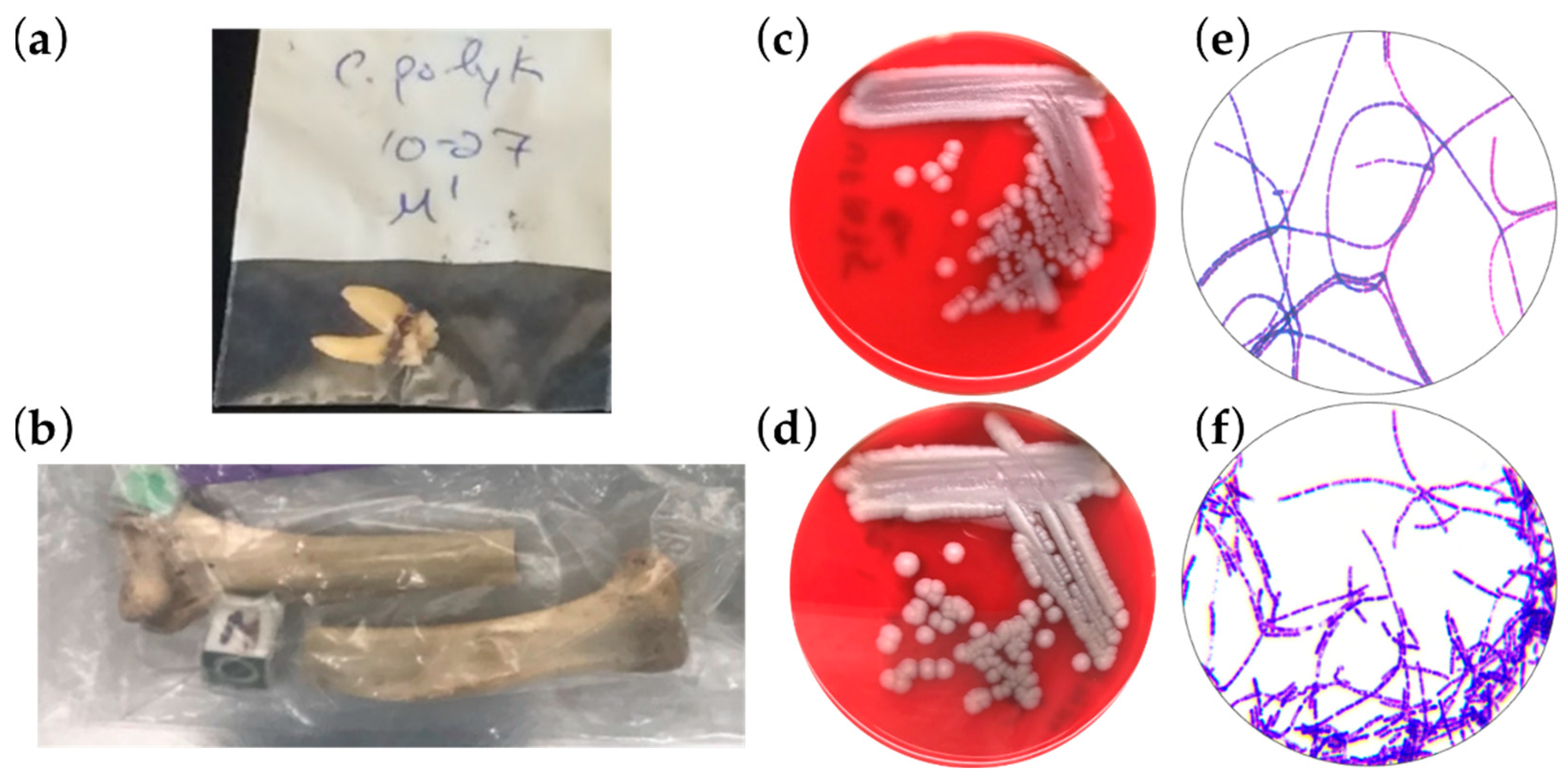
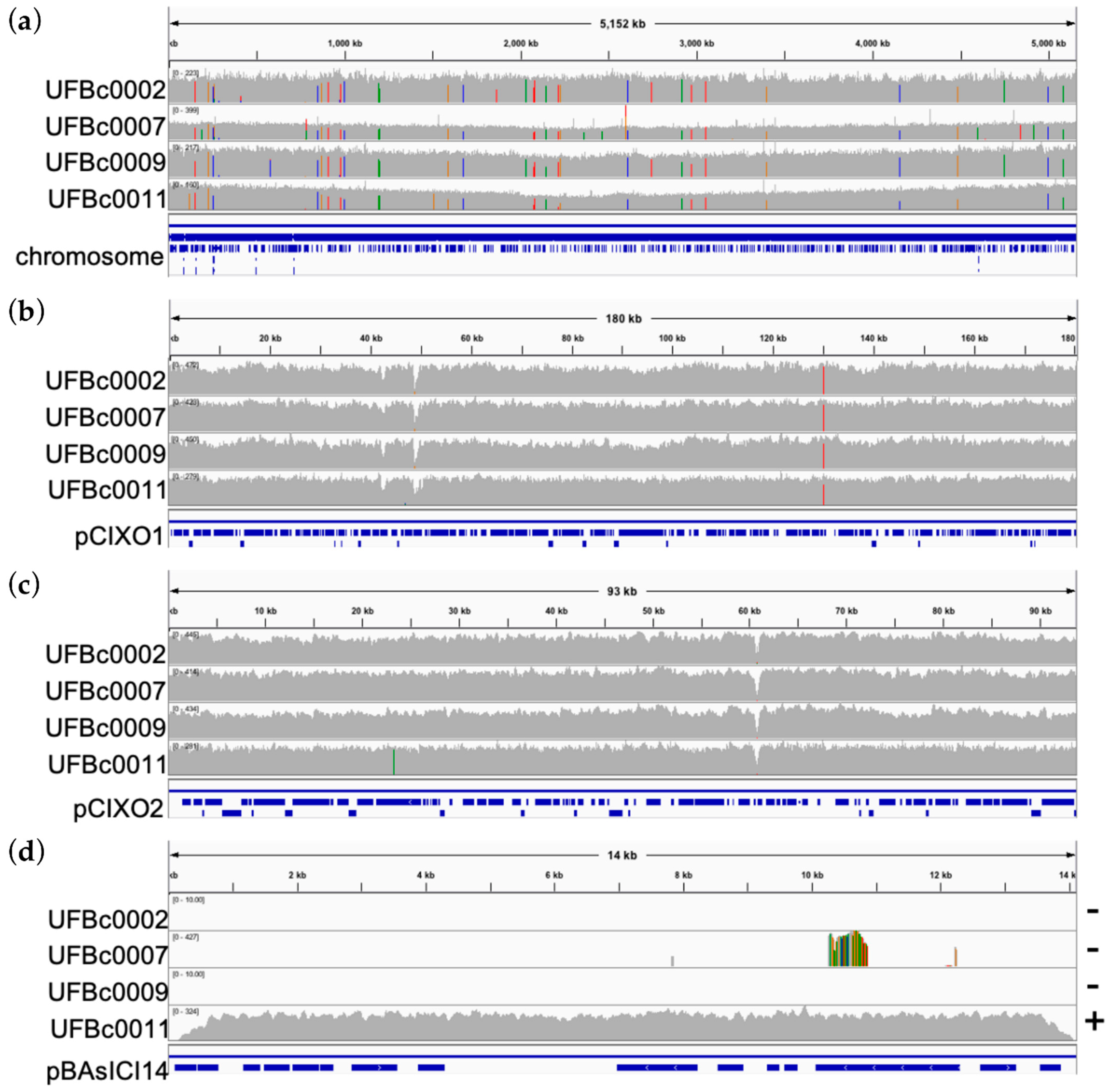
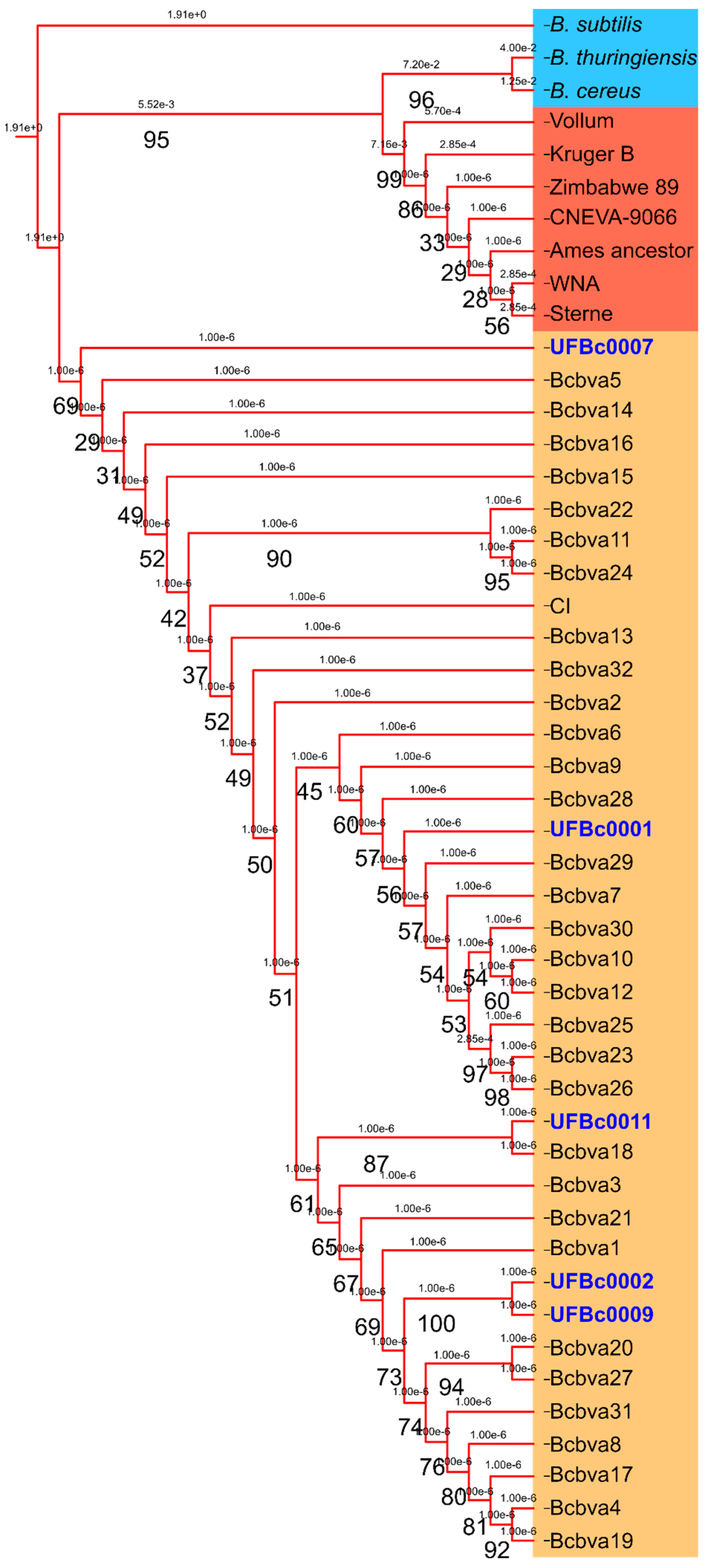
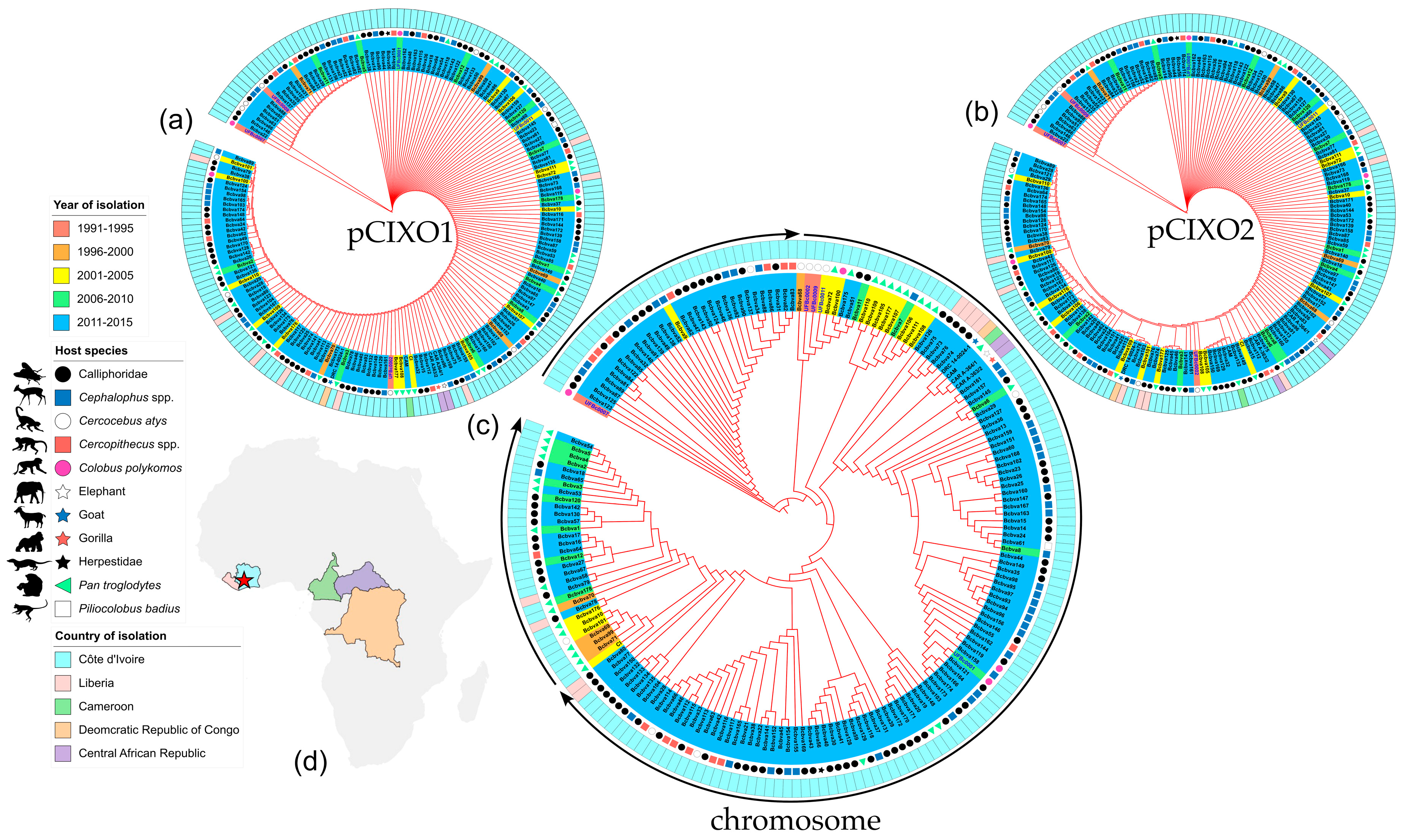
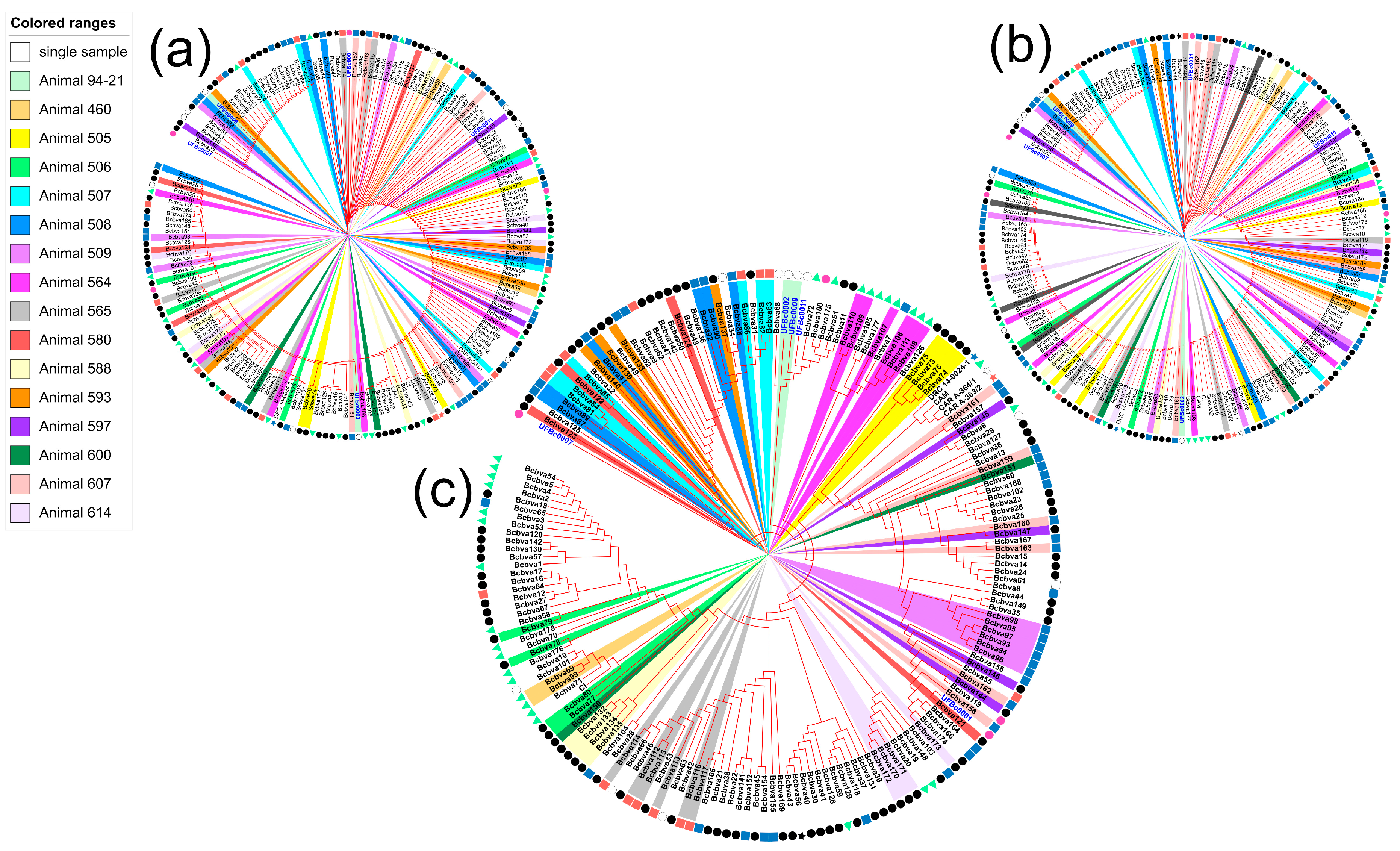
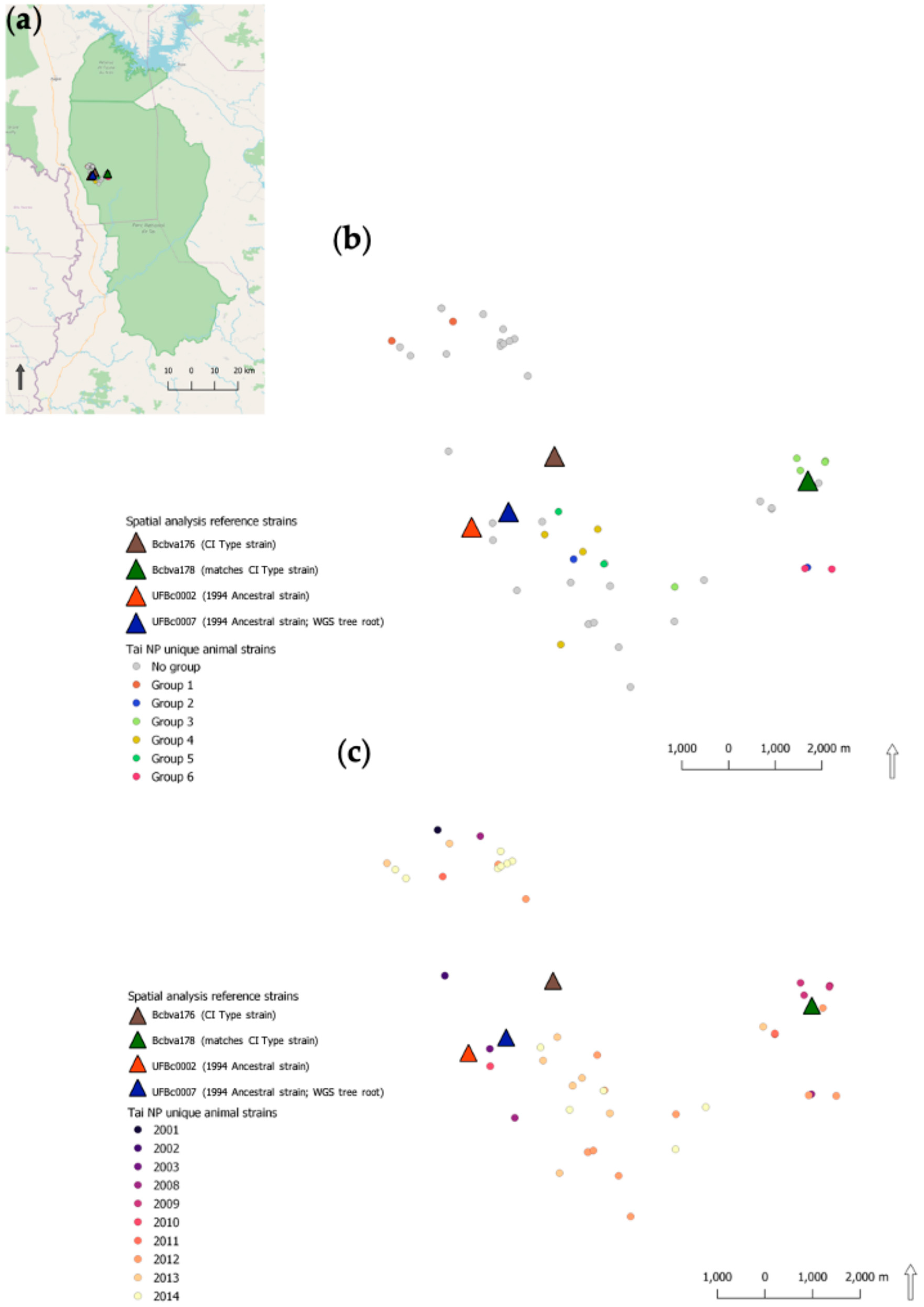
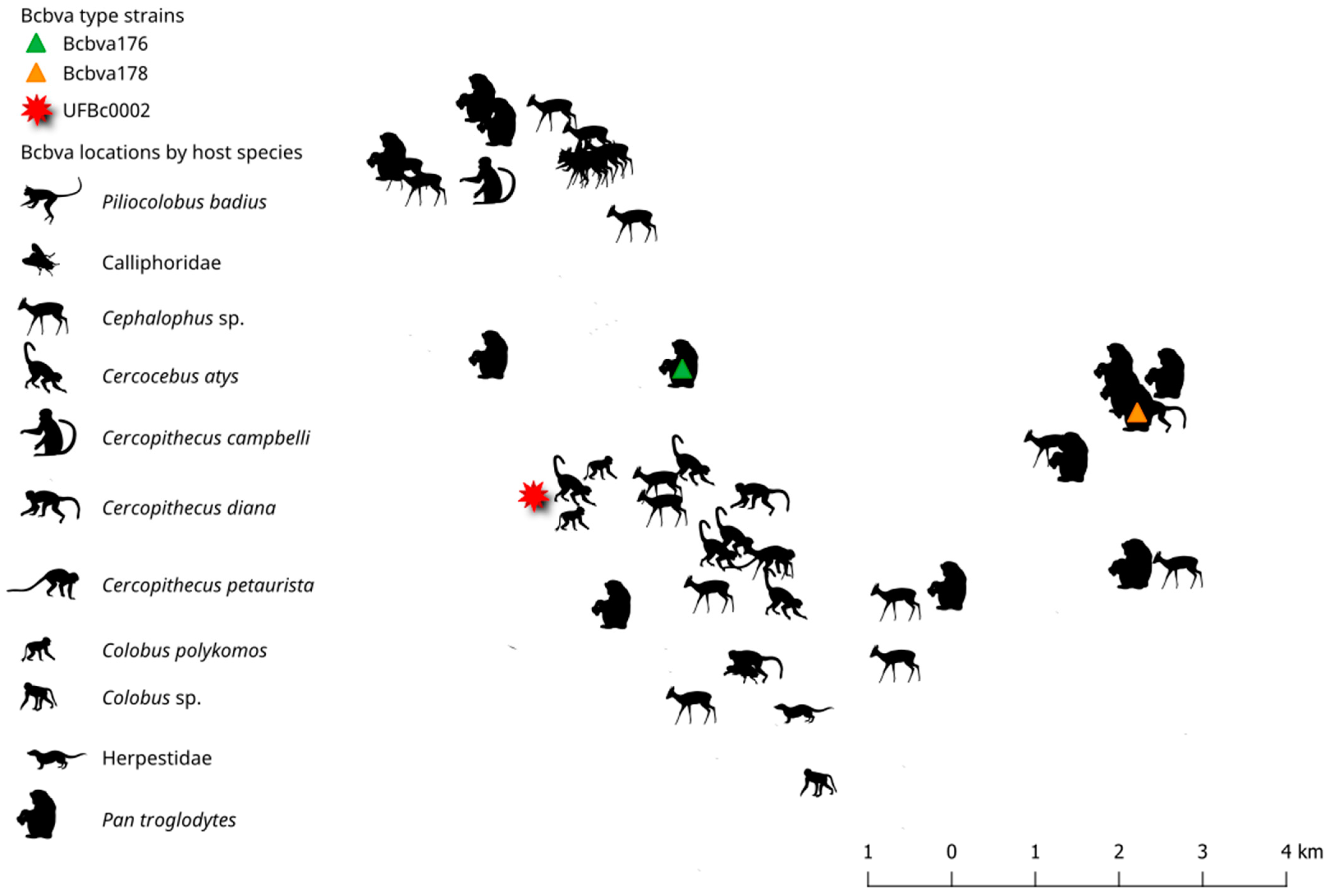
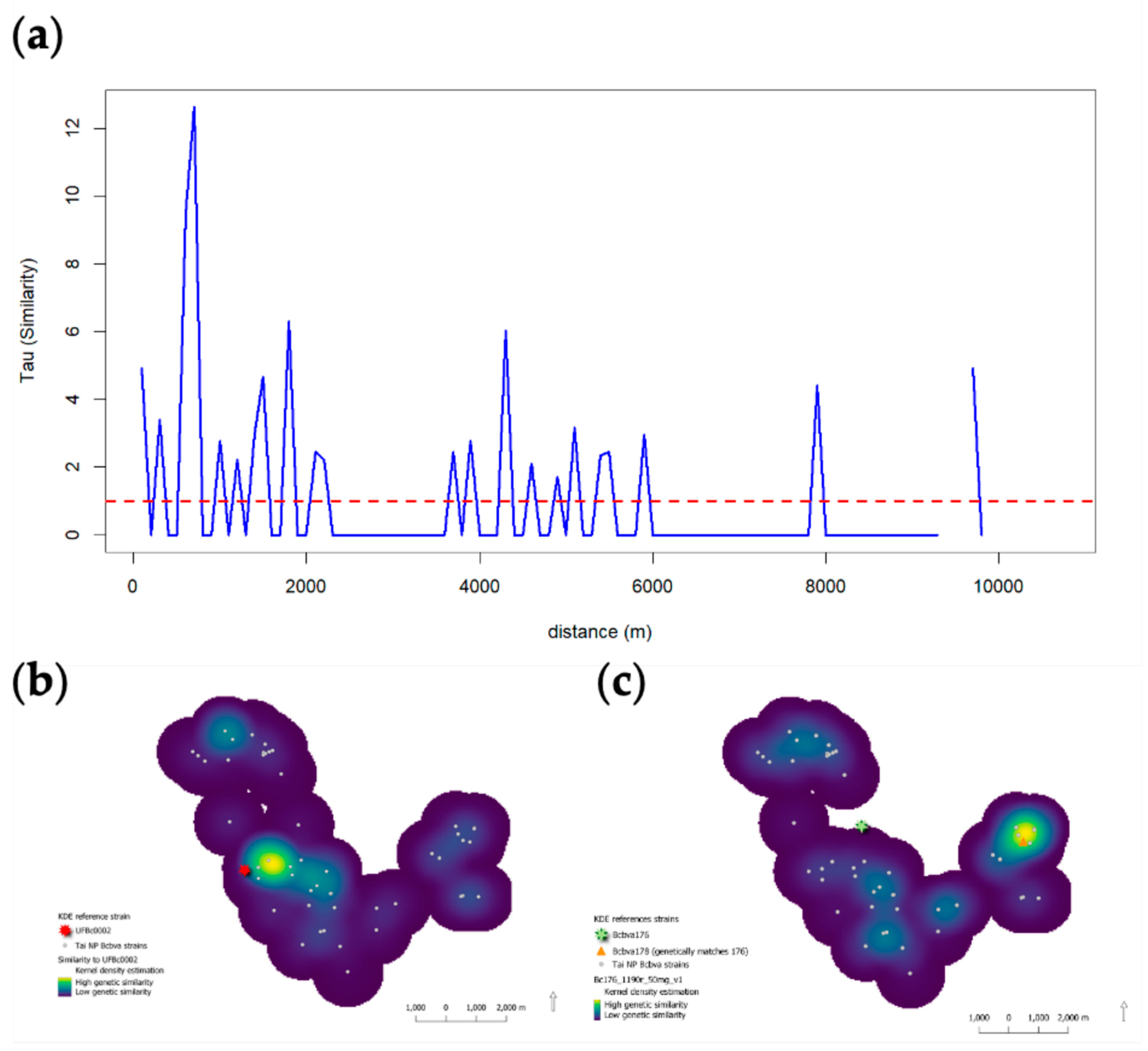
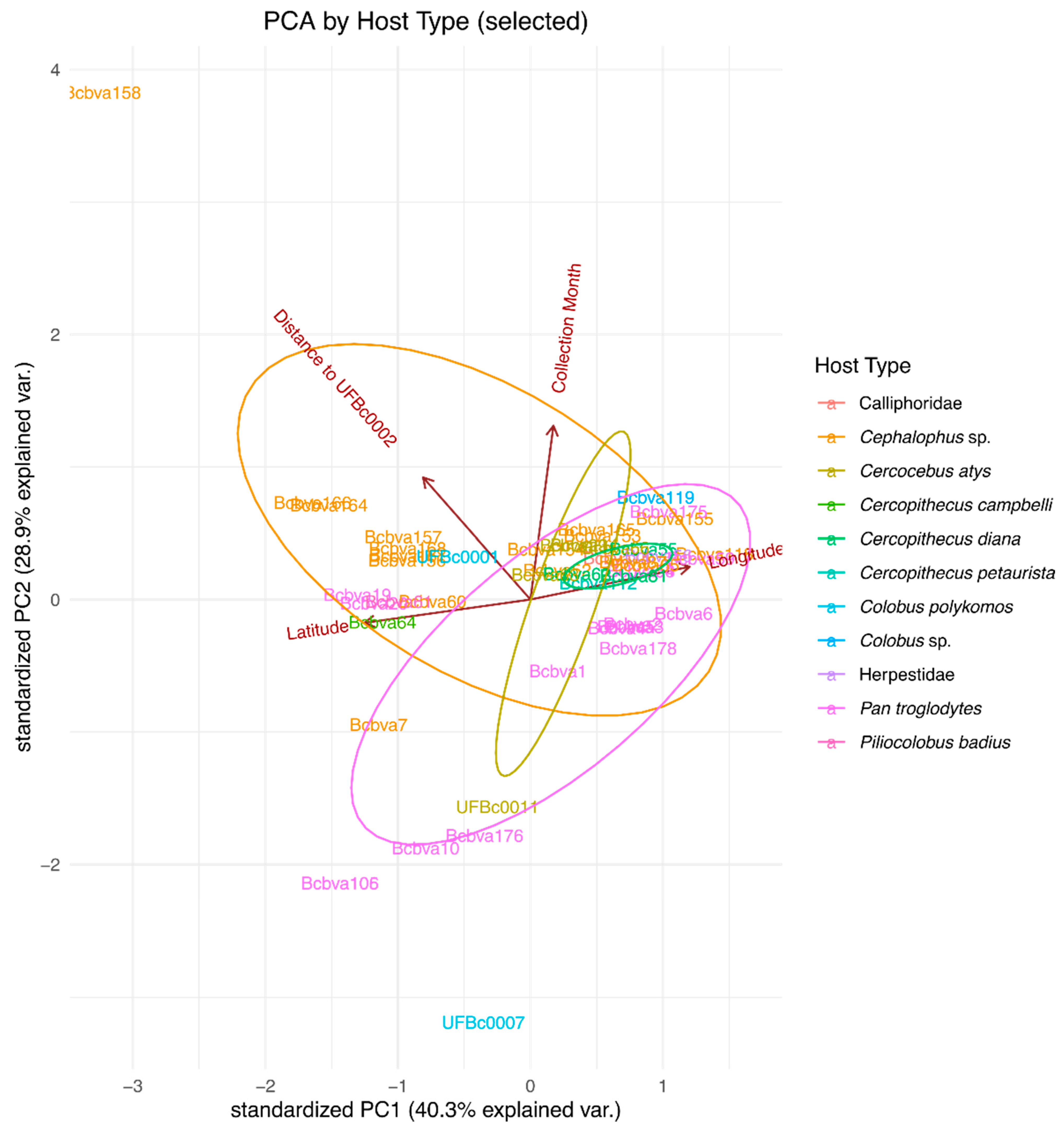
| SEER Lab ID | OSU Bone ID | Host Species | Age Estimate | Samples | Associated Pure Culture |
|---|---|---|---|---|---|
| 38 | 10–27 | Colobus polykomos | 4–6 years; adult male | Tooth, M1 | UFBc0001 |
| 78 | 94–21 | Cercocebus atys | 7–10 years; adult male | Left humerus | UFBc0002 |
| 102 | 94–21 | Mandible scrapings and associated tooth | UFBc0009 | ||
| 83 | 94–31 | Colobus polykomos | 4–6 years; adult female | Right humerus | UFBc0007 |
| 174 | 23–10 | Cercocebus atys | 1–2 years; juvenile | Mandible fragment | UFBc0011 |
| Locus | ST | Country | Year | Host Species | |||||||
|---|---|---|---|---|---|---|---|---|---|---|---|
| Strain | glp | gmk | ilv | pta | pur | pyc | tpi | ||||
| CI | 34 | 1 | 83 | 1 | 18 | 29 | 5 | 935 | Côte d’Ivoire | 2002 | Pan troglodytes |
| UFBc0001 | 34 | 1 | 83 | 1 | 18 | 29 | 5 | 935 | Côte d’Ivoire | 2010 | Colobus polykomos |
| UFBc0002 * | 34 | 1 | 83 | 1 | 18 | 29 | 5 | 935 | Côte d’Ivoire | 1993–94 | Cerocebus atys |
| UFBc0007 * | 34 | 1 | 83 | 1 | 18 | 29 | 5 | 935 | Côte d’Ivoire | 1993–94 | Colobus polykomos |
| UFBc0009 * | 34 | 1 | 83 | 1 | 18 | 29 | 5 | 935 | Côte d’Ivoire | 1993–94 | Cerocebus atys |
| UFBc0011 * | 34 | 1 | 83 | 1 | 18 | 29 | 5 | 935 | Côte d’Ivoire | 2003 | Cerocebus atys |
| DRC-14-0024-1 | 34 | 1 | 83 | 1 | 18 | 29 | 5 | 935 | DRC | 2012 | goat |
| CAR-A364-1 | 34 | 1 | 83 | 1 | 18 | 29 | 5 | 935 | CAR | 2013 | Gorilla gorilla |
| CAR-A363-2 | 34 | 1 | 83 | 1 | 18 | 29 | 5 | 935 | CAR | 2012 | Elephant |
| CAM | 34 | 1 | 83 | 1 | 18 | 29 | 5 | 935 | CAM | 2014 | Pan troglodytes |
| Bcbva69 | 34 | 1 | 83 | 1 | 18 | 29 | 5 | 935 | Côte d’Ivoire | 1996 | Pan troglodytes |
| Bcbva172 | 34 | 1 | 83 | 1 | 18 | 29 | 5 | 935 | Côte d’Ivoire | 2014 | Calliphoridae |
| Bcbva73 | 34 | 1 | 83 | 1 | 18 | 29 | 5 | 935 | Liberia | 2013 | Calliphoridae |
| Bcbva80 | 34 | 1 | 83 | 1 | 18 | 29 | 5 | 935 | Liberia | 2013 | Calliphoridae |
Disclaimer/Publisher’s Note: The statements, opinions and data contained in all publications are solely those of the individual author(s) and contributor(s) and not of MDPI and/or the editor(s). MDPI and/or the editor(s) disclaim responsibility for any injury to people or property resulting from any ideas, methods, instructions or products referred to in the content. |
© 2023 by the authors. Licensee MDPI, Basel, Switzerland. This article is an open access article distributed under the terms and conditions of the Creative Commons Attribution (CC BY) license (https://creativecommons.org/licenses/by/4.0/).
Share and Cite
Norris, M.H.; Zincke, D.; Daegling, D.J.; Krigbaum, J.; McGraw, W.S.; Kirpich, A.; Hadfield, T.L.; Blackburn, J.K. Genomic and Phylogenetic Analysis of Bacillus cereus Biovar anthracis Isolated from Archival Bone Samples Reveals Earlier Natural History of the Pathogen. Pathogens 2023, 12, 1065. https://doi.org/10.3390/pathogens12081065
Norris MH, Zincke D, Daegling DJ, Krigbaum J, McGraw WS, Kirpich A, Hadfield TL, Blackburn JK. Genomic and Phylogenetic Analysis of Bacillus cereus Biovar anthracis Isolated from Archival Bone Samples Reveals Earlier Natural History of the Pathogen. Pathogens. 2023; 12(8):1065. https://doi.org/10.3390/pathogens12081065
Chicago/Turabian StyleNorris, Michael H., Diansy Zincke, David J. Daegling, John Krigbaum, W. Scott McGraw, Alexander Kirpich, Ted L. Hadfield, and Jason K. Blackburn. 2023. "Genomic and Phylogenetic Analysis of Bacillus cereus Biovar anthracis Isolated from Archival Bone Samples Reveals Earlier Natural History of the Pathogen" Pathogens 12, no. 8: 1065. https://doi.org/10.3390/pathogens12081065
APA StyleNorris, M. H., Zincke, D., Daegling, D. J., Krigbaum, J., McGraw, W. S., Kirpich, A., Hadfield, T. L., & Blackburn, J. K. (2023). Genomic and Phylogenetic Analysis of Bacillus cereus Biovar anthracis Isolated from Archival Bone Samples Reveals Earlier Natural History of the Pathogen. Pathogens, 12(8), 1065. https://doi.org/10.3390/pathogens12081065





